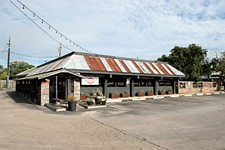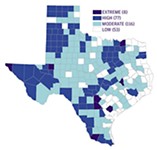VMU: Coming Soon Near You
Time to weigh in on Vertical Mixed Use zoning
By Katherine Gregor, Fri., March 23, 2007
On March 5, letters went out to neighborhood leadership that started the 90-day clock ticking for input into Austin's new VMU zoning. Individual neighborhoods have a one-time "window" to recommend that City Council customize VMU zoning provisions in their hood. Those that are within a Vertical Mixed-Use Overlay District (see map at www.ci.austin.tx.us/planning/verticalmixeduse.htm) can choose to "opt-out" of some features. Those that aren't in a VMU-OD but wish they were can "opt-in" specific parcels of land.
As part of the city's new commercial design standards, VMU zoning was created to encourage well-designed urban infill and redevelopment projects along core transit corridors throughout Austin – current and future. In a VMU project, at least two stories of apartments or condos must rise above ground-floor retail or other commercial space, and at least 10% of the living units must be affordable housing. Overall, VMU supports the city's vision for denser, high-quality development. Rachel Proctor May, policy director for Council Member Brewster McCracken, reports that neighborhoods are most excited about the good-design features – such as handsome storefronts that meet the street, sidewalk cafes, pedestrian-friendly amenities, well-scaled buildings, and sustainable green building. She foresees that this could be the historical moment when "neighborhoods stand up and say, 'Yes, we do want density, if it goes with good design.'"
Katrina Daniel, active in both the Highland Neighborhood Association and the Austin Neighborhoods Council, said of VMU, "We're pretty excited about the prospect. People are starting to realize that the neighborhood can change for the better. What this ordinance gives us is the opportunity to shape growth, along North Lamar and Airport Boulevard, in a way that doesn't disrupt the neighborhood's single-family core." She said that in Highland, which has an average household income of $63,000, the inclusion of affordable housing has been positively received. The Neighborhood Planning Team, a designated group of leaders that led the Neighborhood Plan process for the city, has already met once on VMU and made plans to attend one of McCracken's community meetings (see below) and a city staff meeting; the team will then reconvene to compile any "opt-in/opt-out" requests.
Neighborhood recommendations go first to the Planning Commission for review, then to council for a vote (within 45 days). While a neighborhood can't opt-out of VMU entirely, in areas where it's permitted, it can ask to opt-out specific tracts of land (where redevelopment is not desired) and to broadly opt-out of certain developer incentives that encourage VMU. To voice opinions on VMU in your area, contact your neighborhood association. The clock on the 90-day neighborhood review period ends soon after June 5.
Got something to say on the subject? Send a letter to the editor.









